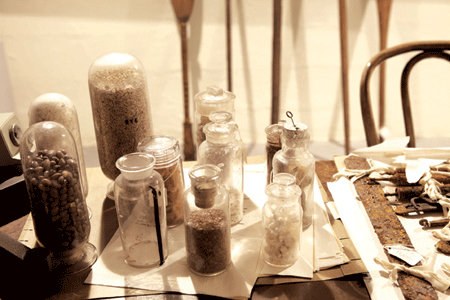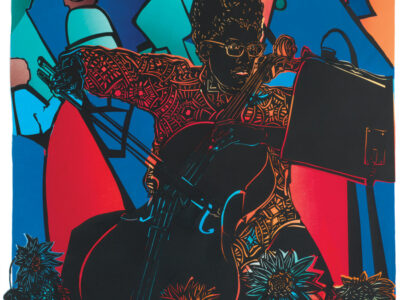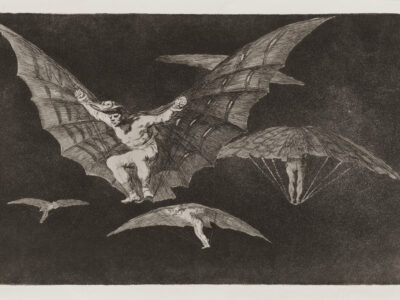
Aaron Levy C’99 G’03, executive director and chief curator of the Slought Foundation, is sitting in his office on the third floor of Fisher-Bennett Hall, lost in thought. At his feet are cardboard boxes; on his shelves are piles and piles of dust-brown artifacts—Polynesian paddles, baskets, terra cotta figurines with the heads knocked off—all part of a recent Slought exhibition titled “Commercial America,” which centered around “leftover” objects from the old Philadelphia Commercial Museum.
Founded in 1899 by Penn botany professor William Wilson, the Commercial Museum, located on the grounds of the old Civic Center, served as the official repository for artifacts of several world’s fairs: the 1939 New York World’s Fair, the 1933 Chicago Exposition, and the 1876 Centennial Exposition in Philadelphia. It closed in 1991, and while some of its artifacts have since made their way into other institutions, those that were never “adopted” ended up in a Girard Avenue storage warehouse owned by the Philadelphia Water Department.
Last winter the city announced that all artifacts unclaimed by February 17, 2010 would be permanently discarded. Nonprofit organizations throughout the city were given first dibs. When word of the offer reached Levy (who is also a lecturer in the English department) about a week before the deadline, he gathered a group of students and Slought workers, rented a U-Haul, and drove to the storage space to collect as many of the remaining artifacts as they could.
Inside, they found bubble wrap strewn all over the floor and a layer of dust so thick it had footprints. Boxes were torn from the shelves and left lying on their sides, their unidentified contents long gone. It looked like the day after a fire sale. All Levy and his students had to do was show the artifacts they had claimed to their colleagues in the city’s Office of Arts, Culture, and the Creative Economy, and they were checked off a list.
After 19 years, the pickings were slim, and they left with what many people would regard as junk: a broken wood-horse saddle, jars of dried flax and seeds, a headdress made of emu feathers. But to Levy, their orphaned, discarded nature was exactly the point.
He decided to devote an entire exhibit to these artifacts at Slought as a way of exploring their cultural status and how that status is determined by the institutions that house them. Working in collaboration with students from his undergraduate Museums and Modern Literature seminar at Penn, they sought a presentation that would stimulate discussion on storage and preservation in museums.
“The question was, what is the right way to display them?” says Levy. “We were really trying to figure out a way that the collection, the exhibition, would be haunted by, and marked by, the origins that give these artifacts so much meaning, but that no longer exists today.”
They decided to offer up some of the artifacts for a library-loan system in which members of the community, from cultural institutions to the most casual of Slought visitors, could check out an artifact and take it home for a set period of time after signing a simple contract. The move was designed to show that cultural stewardship and responsibility belongs not just to curators but to members of the public as well.
But no matter how Levy and his students visualized a new exhibition, they kept coming back to the storage warehouse.
“The way in which these artifacts had been haphazardly stored for many years struck me as very theatrical and very dramatic,” he says, “and ideally we would have simply brought the public there.”
The exhibition, which ended last month, took the form of a simulated workspace. Polynesian paddles leaned against the wall while an LCD monitor played a slideshow of images from inside the Water Department storage building. In the background was a recording of Levy and his students discussing questions they had raised about the exhibition. Artifacts were displayed on an old writing table, on cardboard boxes, even on the floor—without a single caption.
“Not having captions was in part a decision to raise questions about the ‘lost’ status of the artifacts,” noted one of the student-collaborators, “but it was also a simple reflection of the fact that we didn’t know what these objects were.”
If the questions posed by the exhibition don’t always lend themselves to easy answers, they do stimulate public engagement.
“At Slought,” says Levy, “we like to think of an exhibit as a thought experiment, and it launches a series of questions without worrying where those questions will end.”
—Ty Russell C’11




